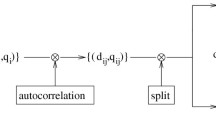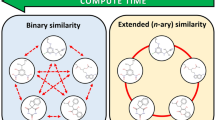Abstract
This article revisits a particular aspect of the molecular similarity principle—the Neighborhood Behavior (NB) concept. Earlier, the NB optimality criterion was introduced to select descriptor spaces, combining a given descriptor set and a similarity metric, which optimally comply with the similarity principle. Here, we focus on a “local” analysis based on the neighborhood of individual bioactive compounds. The defined NB-score measures similarity-based virtual screening success when using individual actives as queries. Systematic studies of local NB have been performed on a large combinatorial library of compounds with reported IC 50 values for five proteases, involving more than 140 descriptor/metric combinations of various fragment- and pharmacophore-based descriptors and different similarity metrics. Although, for each descriptor/metrics combination, the NB-score heavily depends on the query compound, on the average, 2D pharmacophore-based descriptors outperformed their 3D counterparts.







Similar content being viewed by others
References
Papadatos G, Cooper AWJ, Kadirkamanathan V, Macdonald SJF, McLay IM, Pickett SD, Pritchard JM, Willett P, Gillet VJ (2009) Analysis of neighborhood behavior in lead optimization and array design. J Chem Inf Model 49(2):195–208. doi:10.1021/ci800302g
Horvath D, Barbosa F (2004) Neighborhood behavior—the relation between chemical similarity and property similarity. Curr Trends Med Chem 4:589–600
Horvath D, Jeandenans C (2003) Neighborhood behavior of in silico structural spaces with respect to in vitro activity spaces—a novel understanding of the molecular similarity principle in the context of multiple receptor binding profiles. J Chem Inf Comput Sci 43:680–690
Patterson DE, Cramer RD, Ferguson AM, Clark RD, Weinberger LE (1996) Neighborhood behavior: a useful concept for validation of “molecular diversity” descriptors. J Med Chem 39(16):3049–3059
Maggiora GM (2006) On outliers and activity cliffs—why QSAR often disappoints. J Chem Inf Model 46:1535
Johnson M, Maggiora GM (1990) Concepts and applications of molecular similarity. Wiley, New York
Willett P, Barnard JM, Downs GM (1998) Chemical similarity searching. J Chem Inf Model 38:983–996
Varnek A, Fourches D, Hoonakker F, Solov’ev VP (2005) Substructural fragments: an universal language to encode reactions, molecular and supramolecular structures. J Comput Aided Mol Des 19(9–10):693–703
Solov’ev VP, Varnek AA (2004) Structure-property modeling of metal binders using molecular fragments. Russ Chem Bull 53(7):1434–1445
Schneider G, Schneider P, Renner S (2006) Scaffold-hopping: how far can you jump? QSAR Comb Sci 25:1162–1171
Renner S, Schneider G (2006) Scaffold-hopping potential of ligand-based similarity concepts. Chem Med Chem 1:181
Schuller A, Fechner U, Renner S, Franke L, Weber L, Schneider G (2006) A pseudo-ligand approach to virtual screening. Comb Chem High Throughput Screen 9(5):359–364
Schneider G, Lee M-L, Stahl M, Schneider P (2000) De novo design of molecular architectures by evolutionary assembly of drug-derived building blocks. J Comput Aided Mol Des 14:487–494
Schneider G, Neidhart W, Giller T, Schmid G (1999) “Scaffold-Hopping” by topological pharmacophore search: a contribution to virtual screening. Angew Chem Int Ed Engl 38:2894–2896
Tanrikulu Y, Nietert M, Scheffer U, Proschak E, Grabowski K, Schneider P, Weidlich M, Karas M, Goebel M, Schneider G (2007) Scaffold hopping by “fuzzy” pharmacophores and its application to RNA targets. Chem Bio Chem 8:1932–1936
Bonachera F, Horvath D (2008) Fuzzy tricentric pharmacophore fingerprints. 2. Application of topological fuzzy pharmacophore triplets in quantitative structure-activity relationships. J Chem Inf Model 48(2):409–425
Bonachera F, Parent B, Barbosa F, Froloff N, Horvath D (2006) Fuzzy tricentric pharmacophore fingerprints. 1. Topological fuzzy pharmacophore triplets and adapted molecular similarity scoring schemes. J Chem Inf Model 46:2457–2477
ChemAxon (2007) Screen user guide. http://www.chemaxon.com/jchem/index.html?content=doc/user/Screen.html. Accessed Feb. 2009 2010
Ugi I, Steinbrückner C (1960) Über ein neues Kondensationsprinzip. Angew Chem 72:267–268
Ugi I, Meyr R, Fetzer U, Steinbrückner C (1959) Versuche mit Isonitrilen. Angew Chem 71:368
Weber L (2002) Multi-component reactions and evolutionary chemistry. Drug Discovery Today 7:143–147
Weber L, Wallbaum S, Gubernator K, Broger C (1995) Optimization of the biological activity of combinatorial compound libraries by a genetic algorithm. Angew Chem Int Ed Engl 34:2280–2282
Weber L (2002) The application of multi-component reactions in drug discovery. Curr Med Chem 9:2085–2093
Varnek A, Fourches D, Horvath D, Klimchuk O, Gaudin C, Vayer P, Solov’ev V, Hoonakker F, Tetko IV, Marcou G (2008) ISIDA-Platform for virtual screening based on fragment and pharmacophoric descriptors. Curr Comput Aided Drug Des 4(3):191–198
Varnek A, Fourches D, Solov’ev V, Klimchuk O, Ouadi A, Billard I (2007) Successful “in silico” design of new efficient uranyl binders. Solvent Extr Ion Exch 25(4):433–462. doi:10.1080/07366290701415820
CORINA (2005) Molecular Networks. 3.2 edn. GmbH, Erlangen
Kornhuber J, Terfloth L, Bleich S, Wiltfang J, Rupprecht R (2009) Molecular properties of psychopharmacological drugs determining non-competitive inhibition of 5-HT3A receptors. Eur J Med Chem 44(6):2667–2672
Horvath D, Bonachera F, Solov’ev V, Gaudin C, Varnek A (2007) Stochastic versus stepwise strategies for quantitative structure-activity relationship generation. How much effort may the mining for successful QSAR models take? J Chem Inf Model 47:927–939
Welch BL (1947) The generalization of “Student’s” problem when several different population variances are involved. Biometrika 34:28–35
Martin YC, Muchmore S (2009) Beyond QSAR: lead hopping to different structures. Qsar Comb Sci 28(8):797–801. doi:10.1002/qsar.200810176
Muchmore SW, Debe DA, Metz JT, Brown SP, Martin YC, Hajduk PJ (2008) Application of belief theory to similarity data fusion for use in analog searching and lead hopping. J Chem Inf Model 48(5):941–948. doi:10.1021/ci7004498
Horvath D, Jeandenans C (2003) Neighborhood behavior of in silico structural spaces with respect to in vitro activity spaces—a benchmark for neighborhood behavior assessment of different in silico similarity metrics. J Chem Inf Comput Sci 43:691–698
Cohen J (1960) A coefficient of agreement for nominal scales. Educ Psychol Measur 20:37–46
Brown RD, Martin YC (1996) The information content of 2D and 3D structural descriptors relevant to ligand-receptor binding. J Chem Inf Comput Sci 36:572–584
Sheridan RP, Kearsley SK (2002) Why do we need so many chemical similarity search methods? Drug Discov Today 7(17):903–911
Sheridan RP (2007) Chemical similarity searches: when is complexity justified? Expert Opin Drug Discov 2(4):423–430. doi:10.1517/17460441.2.4.423
Guha R, VanDrie JH (2008) Structure-activity landscape index: identifying and quantifying activity cliffs. J Chem Inf Model 48(3):646–658
Petalson L, Bajorath J (2007) SAR index: quantifying the nature of structure-activity relationships. J Med Chem 50:5571–5578
Martin YC, Kofron JL, Traphagen LM (2002) Do structurally similar molecules have similar biological activity? J Med Chem 45(19):4350–4358. doi:10.1021/jm020155c
Chen BN, Mueller C, Willett P (2010) Combination rules for group fusion in similarity-based virtual screening. Mol Inf 29 (6–7):533–541. doi:10.1002/minf.201000050
Acknowledgments
We are grateful to Dr. L. Weber for providing the Ugi data set. Dr. Y. Tanrikulu is thanked for programming the LIQUID software.
Author information
Authors and Affiliations
Corresponding author
Rights and permissions
About this article
Cite this article
Horvath, D., Koch, C., Schneider, G. et al. Local neighborhood behavior in a combinatorial library context. J Comput Aided Mol Des 25, 237–252 (2011). https://doi.org/10.1007/s10822-011-9416-2
Received:
Accepted:
Published:
Issue Date:
DOI: https://doi.org/10.1007/s10822-011-9416-2




